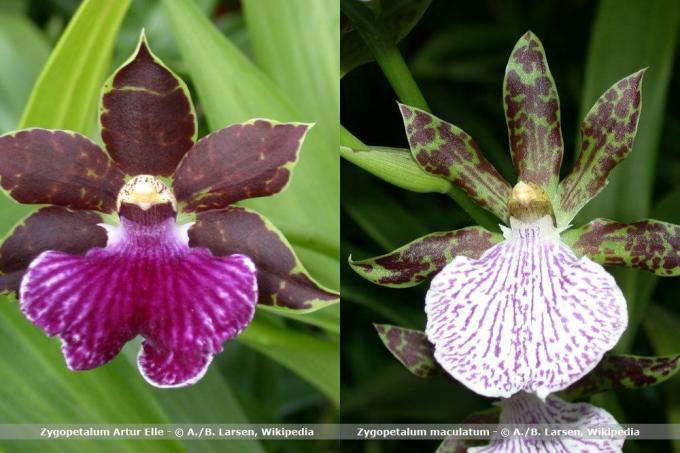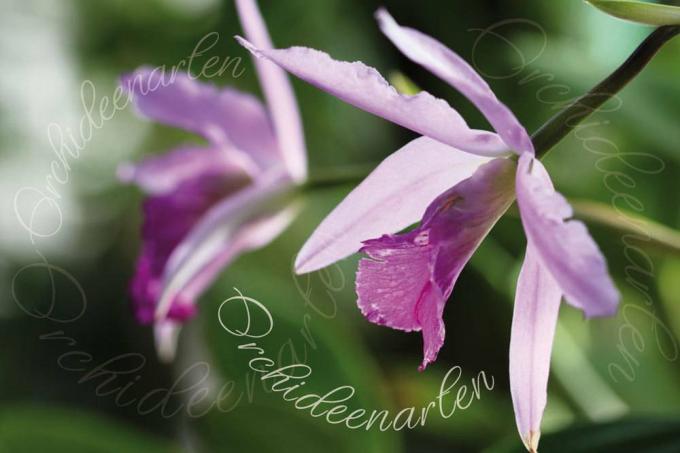
table of contents
- Orchid species
- Varieties with A
- Varieties with B
- Varieties with C
- Varieties with D
- Varieties from E to L
- Varieties from M to S
- Varieties from T to Z
There are currently over 1000 orchid genera and up to 30,000 different species, of which there are numerous subspecies / cultivated forms such as hybrids. The plant expert orchid lexicon with pictures provides an overview of the most popular and widespread orchid species in Central Europe.
Orchid species
Orchids are among the finest plants and most popular flower gifts. It often happens that the exact type is not necessarily known. But the right care often depends on this. The plant expert has put together an encyclopedia that lists the most common orchid species so that you can find your exotic Identify flower beauty by name based on the description and the included pictures and find out interesting facts about them can.
Varieties with A
Aerangis
The Aerangis orchid family has around 50 different species and comes mainly from tropical Africa and Madagascar. One of the most widespread species is the Aegangis articulata. Noticeable features are as follows.
- star-shaped flowers
- mostly flowers growing one above the other
- numerous flowers that smell strongly in the evening
- Available as a hanging and standing flower
- Flower color: white
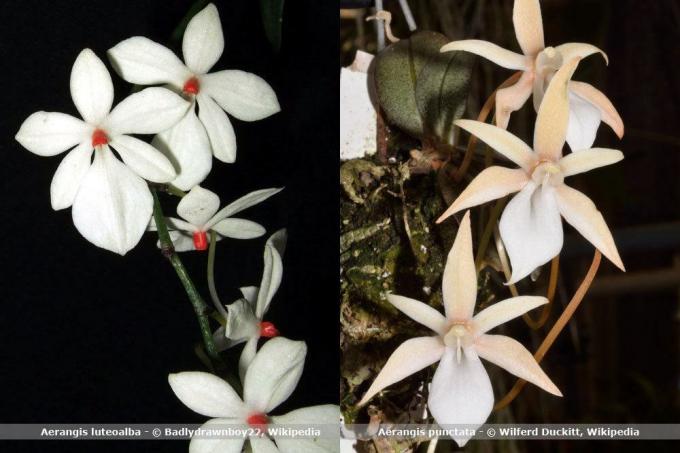
Aerides
Around 20 different species of the Aerides orchid family are available in Central Europe. The best known is the Aerides odorata. It can be recognized by its white flowers with a striking, pink-colored stripe. This type of orchid is native to the Himalayas and the Philippines. It can reach a height of over two meters. Other types are available with white, pink, or red-colored fine flowers.
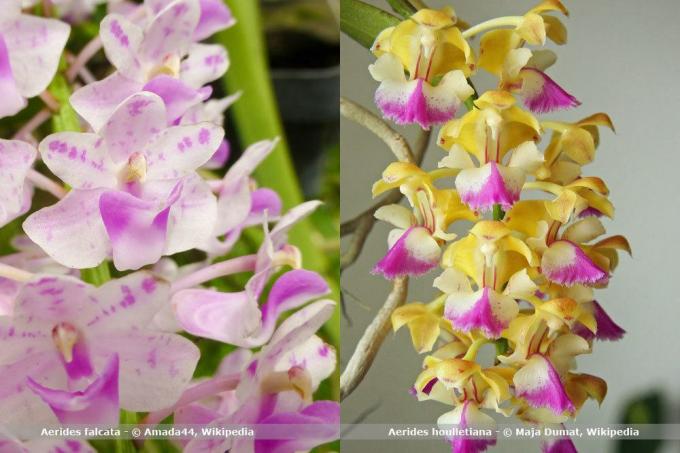
Arundina graminifolia
The Arundina graminifolia comes from the tropical and subtropical regions of Asia. With appropriate care, it can reach a height of up to two meters. Their grass-like leaf dress is striking, with small flowers only forming on the stem ends. The inflorescence is racemose and consists of up to 15 individual flowers turned downwards, of which only two or three open at the same time.
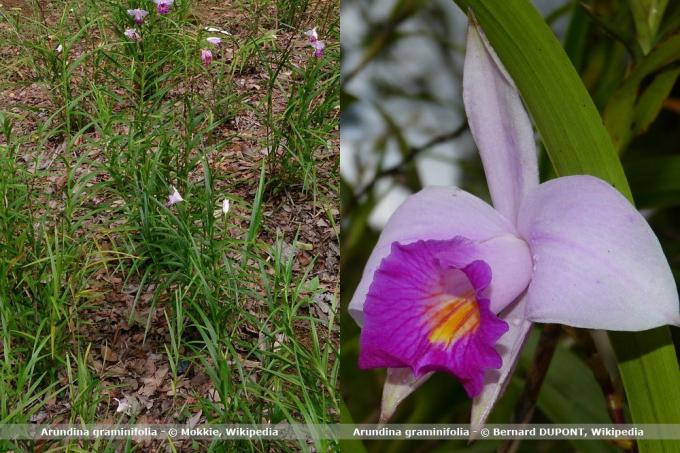
Angraecum
The Angraecum genus consists of around 210 species. These are mostly so-called epiphytic plants, botanically called epiphytic. That means they live on other plants. They originally come from the tropical regions of Africa. The most well-known species include those listed below.
- Angreacum sesquipedale also called "Star of Madagascar", white, large flowers, tapering at the flower ends
- Angreacum leonis has white flowers, but are significantly smaller than those of the sesquipedale
- Angreacum elephantinum is one of the small specimens, but forms large white flowers
- Angreacum viguieri has a size of up to 15 centimeters, has thread-like petals in an orange-brown on a white background
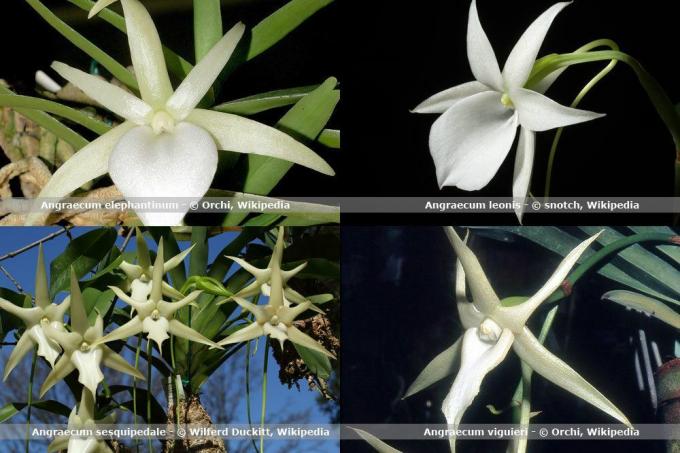
Appendicula
The Appendicula is at home in tropical Asia and has almost 140 species, most of which only occur in Asia. The appendicula can be recognized by its thick, unusually fleshy leaves that are quite small. The following species is very noble.
- Appendicula rubens with very small white flowers that grow on leafy shoots
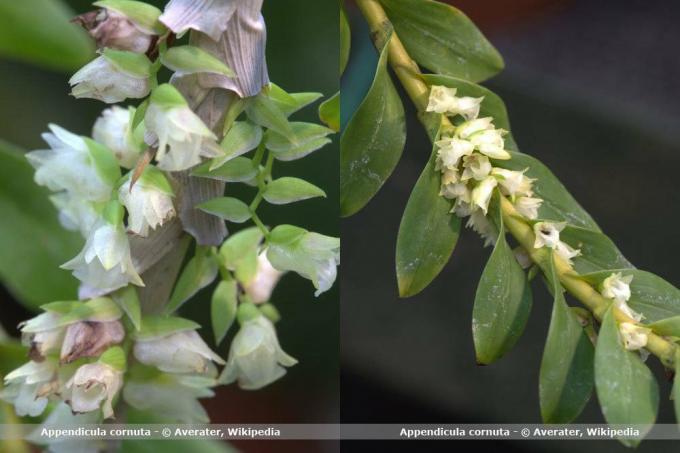
Aspasia
Aspasia is a genus of orchids with only eight different species. It occurs predominantly in Central America. The special thing about it is that it often appears in color combinations that combine white, dark red and shades of brown. The growth takes place via creeping rhizomes, on which pseudobulbs repeatedly form at short intervals. The two varieties listed below are among the most beautiful examples.
- Aspasia lunata with white-pink lips, which are circled in a star-shaped manner by leaves with stripes in a greenish-brown tone
- Aspasia silvana has white lips and the petals are a shade of brown
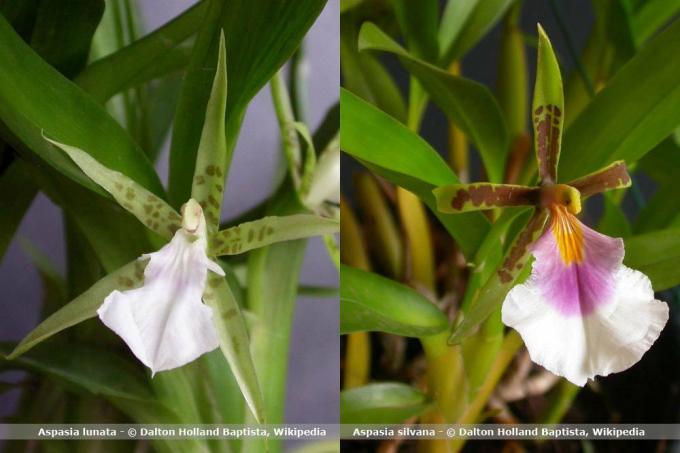
Varieties with B
Barbosella
The Barbosella mainly focuses on two types of orchids, which differ from other types of orchids solely because of their unusual shape. The flower lips point downwards in a lancet shape, while one of the upper petals stands up like an antenna. The Barbosella dolichorhiza is available with purple flowers and the Barbosella hirzii with greenish-yellow flowers.
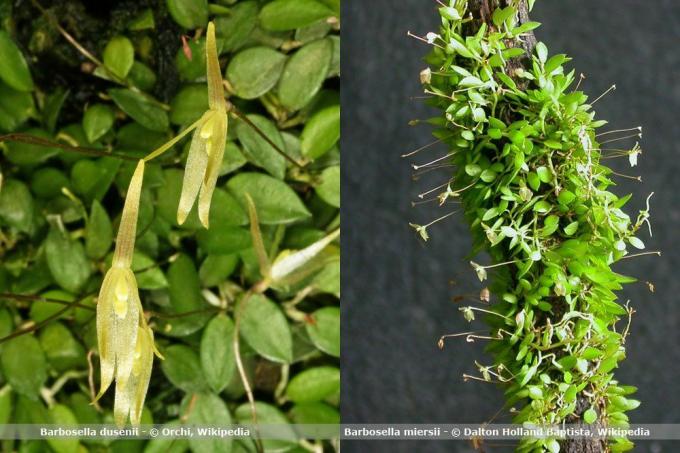
Barkeria
The Barkeria comes from Central America with around 12 species of orchids. Two types in particular are very well known.
- Barkeria spectabilis Available with flowers in different shades of pink
- Barkeria skinneri is particularly noticeable for its bright pink flowers
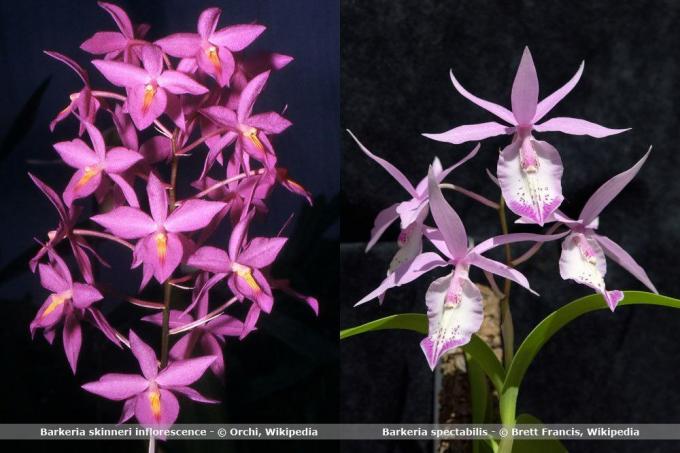
Bifrenaria
In Brazil, the Bifrenaria grows in the wild. It mainly grows on other plants (epiphytic) or on rocky ground. From 21 different species, for example the Bifrenaria aureofulva is a beautiful example of a houseplant. It has several orange flowers and leaves that are reminiscent of sword blades.
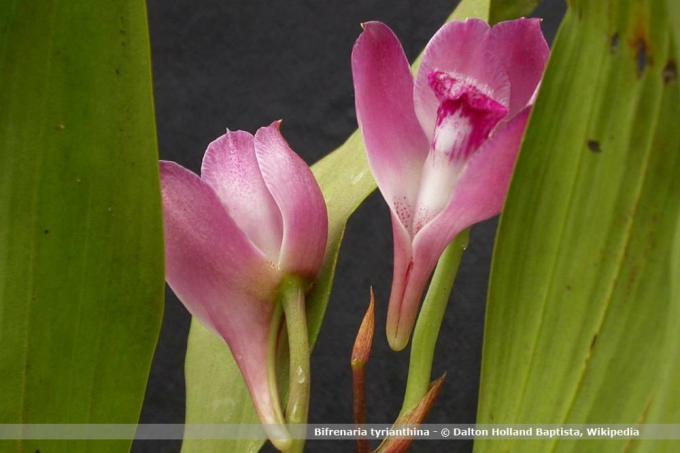
Brassavola
The Brassovola species are among the smallest orchid genera that have creeping rhizomes. As a rule, they only form a white flower, which at most has a different lip color. An essential distinguishing feature are the narrow petals that taper at their ends. The flower lips are folded down like a funnel. In Central Europe, the following types are among the best sellers.
- Brassavola flagellaris with flower lip on a yellow background and white flower
- Brassavola digbyana shows itself with delicately frayed flower edges
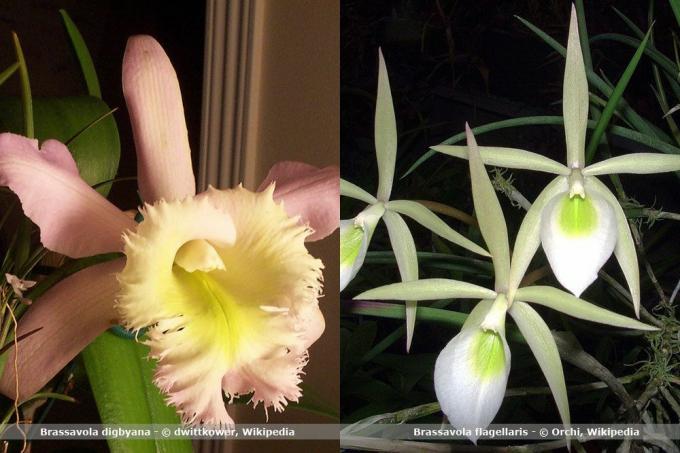
Brassia
Brassia comes from the tropics of America with around 34 known orchid species. Several flowers form on one shoot, which are lined up one behind the other. Particularly noticeable are the petals, which from a distance point like spider legs from the flower core in all directions. The flower colors range from green to white with a slight yellow shimmer. Some specimens have dark spots on the flowers or petals, such as Brassia verrucosa.
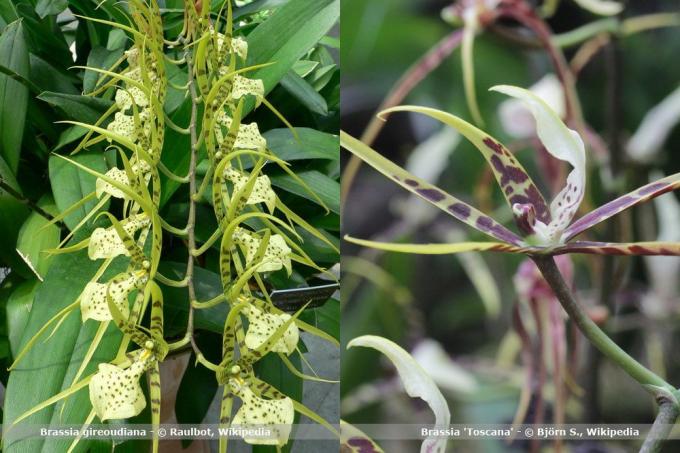
Bulbophyllum
One of the largest orchid genera is the Bulbophyllum with 1,800 species. They are used to warm temperatures all year round and also demand them in Central Europe. Particularly noticeable is the grape-shaped inflorescence that forms on the lowest leaves from the thickenings and pseudobulbs that have grown out of them. The flowers are striking because of their rich colors and their delicately shaped flowers. The following varieties are particularly widespread.
- Bulbophyllum annandalei has white-yellow flowers arranged in the shape of a star with delicate red stripes and a yellow background
- Bulbophyllum carunculatum has elongated petals and a reddish base with a yellow flower
- Bulbophyllum corolliferum shows fine, elongated flowers that are arranged in a semicircle and appear in pink or yellow
- Bulbophyllum delitescens has twisted small flowers in strong pink-red and long lips in the shape of a bag
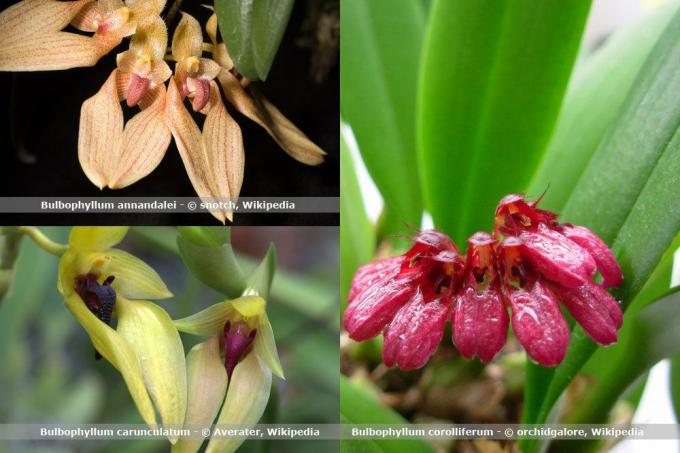
Varieties with C
Calanthe
With a Calanthe you get a specimen of orchids with a combination of two to three different colors. The flowers come from the pseudobulbs, from where they develop into grape-shaped inflorescences. Two types of calanthe are particularly popular in Germany.
- Calanthe discolor shows white flowers with reddish brown
- Calanthe triplicata has a white flower with an orange throat and a split flower lip
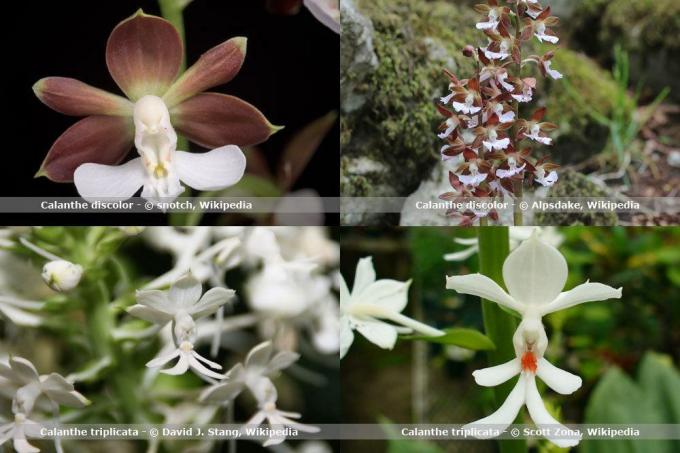
Cattleya
There are around 45 species of the Cattleyen orchid, all of which can be recognized by their rather large flowers. Some specimens smell. The choice of colors extends to yellow, white and pink in different nuances. Most of the following types are offered.
- Cattleya kerii with a bloom that appears completely pink
- Cattleya guttata shows itself with a pink flower lip and shiny green petals on which dark dots are distributed
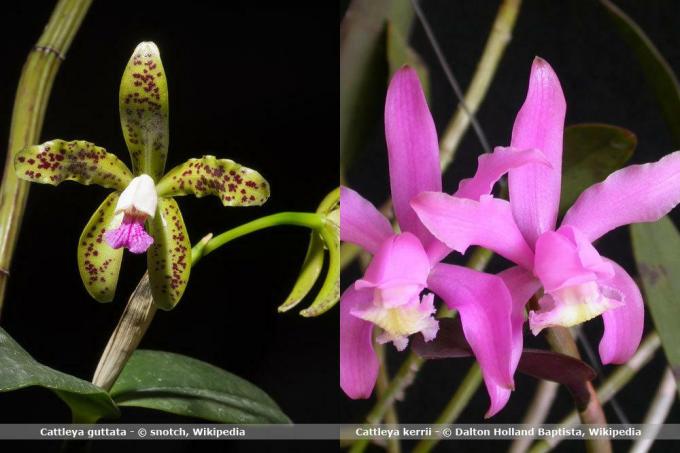
Ceratostylis
The Ceratostylis orchids, which have over 140 species, are among the mini orchids up to a maximum height of 20 centimeters. The species originating from Asia are characterized by their ease of care. Most plants have five slender petals and the lip of the flower is often a different color. They are available as hanging and standing plants. Two types of orchid in particular are widespread.
- Ceratostylis rubra with strong orange flowers and darker lips as well as long, lanceolate leaves
- Ceratostylis philippinensis has pure white flowers with a plump core in the middle and long, slender leaves
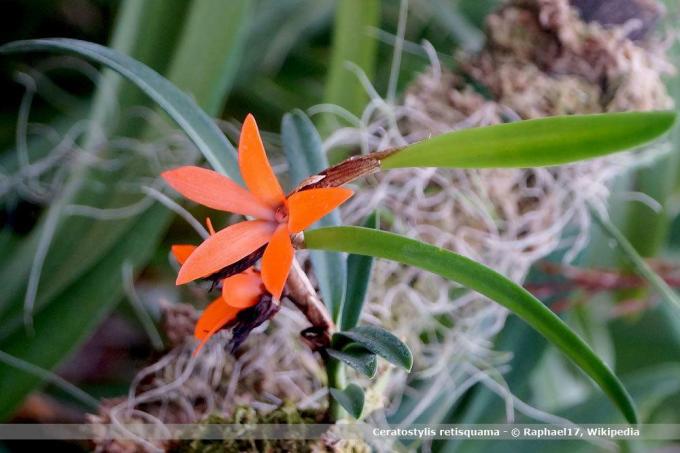
Chysis
The 10 species of Chysis orchids originate from the humid forests of Central and Central America. They have relatively large petals. The leaves are only found in the upper third of the stems. One of the best-known species is the Chysis laevis with orange or yellow flowers.
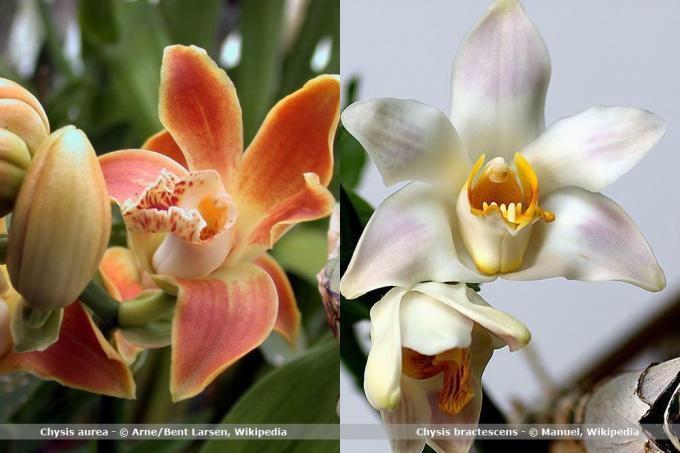
Varieties with D
Dendrobium
The Dendrobium species are also called grape orchids, of which there are around 1,500 different variations. They are the most popular orchid specimens in Germany and, despite their descent from tropical climes, feel very comfortable as indoor plants in Central Europe. Countless shapes and flower colors are available. Most of them stand out from other orchids because of the variety of flowers. Among the best-known species are these here.
- Dendrobium farmeri with numerous flowers in white and unusually large flower stems
- Dendrobium mohlianum with palm-like leaves and mostly leafless shoots on which orange flowers bloom
- Dendrobium nobile is the most well-known species with long rows of flowers in the color combinations white, purple and / or pink
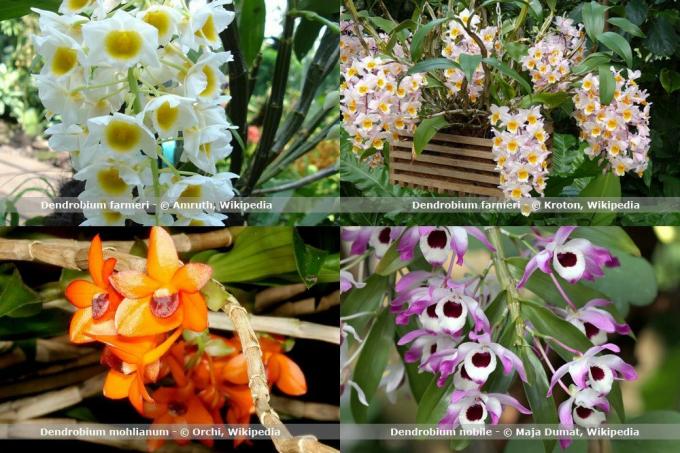
Dendrochilum
A dendrochilum is easy to recognize, with leaves that grow like grass and spike-shaped flower panicles. Depending on the stage of development, the flower stalks bend slightly downwards. The following types of orchids are mainly offered in stores.
- Dendrochilum wenzelii with small orange-red petals that fold far outwards
- Dendrochilum yuccifolium similar to the "Wenzelii", but with greenish white petals
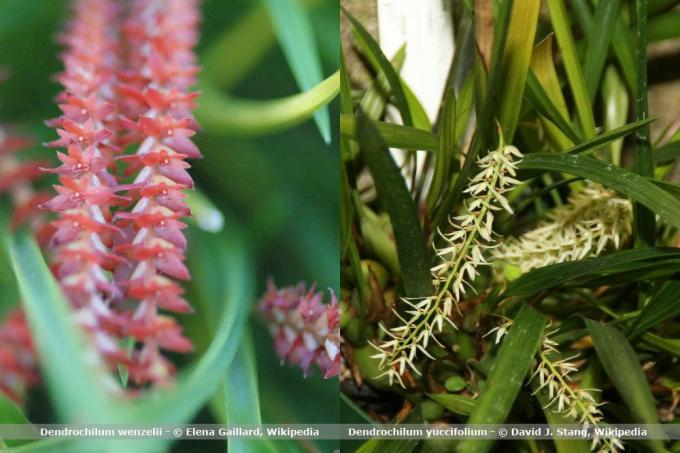
Varieties from E to L
Epidendrum
An epidendrum is an epiphytic orchid variant that feels very comfortable on other plants. Around 1,500 different species are known, most of which come from Central and South America and all of which have a growth on a rhizome. Below the flower stalks there are usually long, thick leaves that almost feel like leather. Healthy plants produce between six and 14 flowers. Three of the most popular types are these.
- Epidendrum magnoliae with delicate white petals
- Epidendrum radicans impresses with flowers in a strong red shade
- Epidendrum ibaguense usually with flower heads consisting of many flowers in orange, red, pink or purple
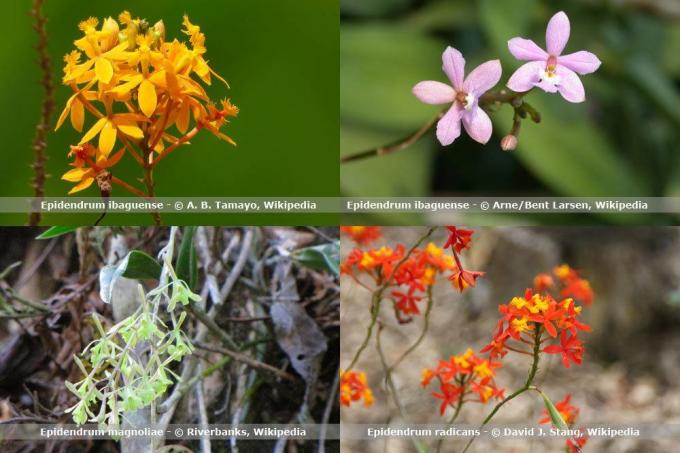
Gongora
The gongora occurs naturally in Brazil and Mexico. The genus includes around 25 different types of orchid, all of which have pointed petals and different colors of the petals and lips. The Gongora maculata is best known in Germany. You can recognize it by the long, rising leaves, yellow flower lips and a red-brown flower color.
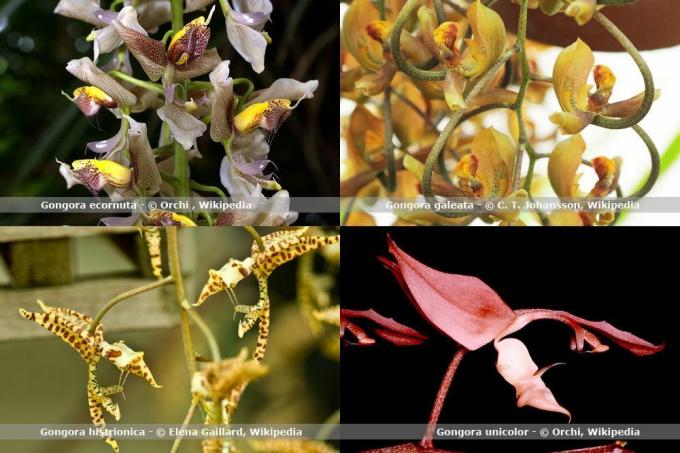
Liparis
The genus Liparis includes not only a tropical species but also native specimens such as the Example the Liparis loeselii, which is also known under the name, peat or marsh gloss herb or gloss orchis is known. It has stable, mostly upwardly protruding leaves, above the height of which the flower stalks with several flowers rise. The small flowers impress with their wide-spreading petals in a shade of yellow.
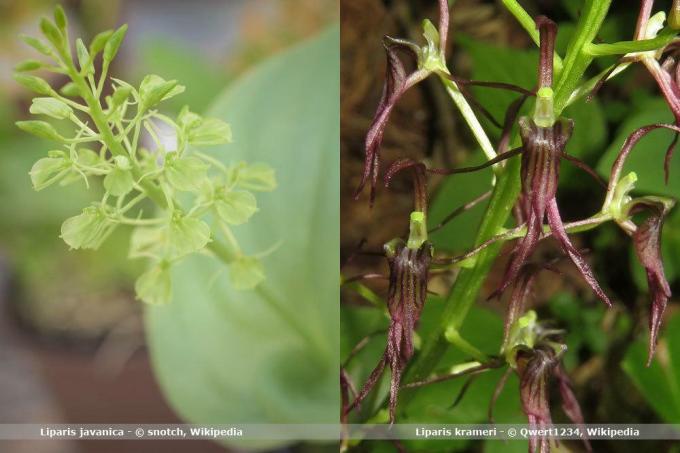
Varieties from M to S
Masdevallia
The Masdevallia species, of which there are around 400, show themselves with a spectacular flower dress. Most of these species grow in the high Andes of Central and South America. They have lower leaves that grow around the sprouts and appear dry there. The flowers, which consist of three outer leaves, which are usually fused with one another and taper towards one end, are particularly eye-catching.
- Masdevallia rolfeana is a classic species of its genus with connected petals in burgundy red
- Masdevallia herradurae is optically the exception, it has individual, very thin and long petals
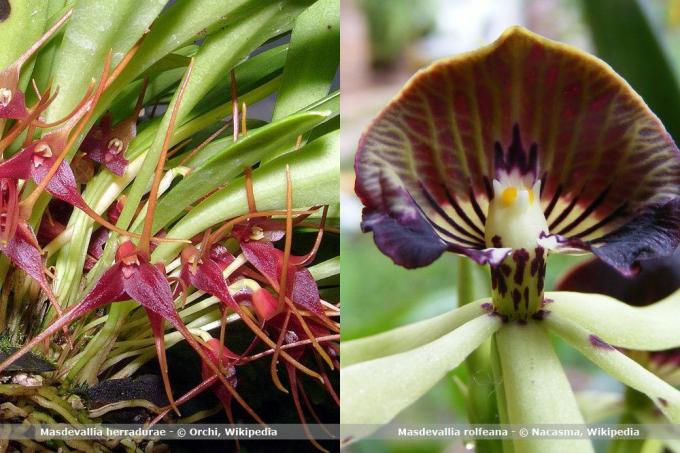
Paphiopedilum
The Venus shoe, as the Paphiopedilum orchids are popularly called, comprises around 100 different species, most of which come from the Asian region. A special feature are the one to three bracts in the upper area of the flower, with a flower bud in front of them. In the lower area is the crown leaf, which resembles the shape of a shoe. Among the most common orchid species are those listed below.
- Paphiopedilum glanduliferum with dark red and white striped petals
- Paphiopedilum gratrixianum with white and orange-colored petals and an orange petal
- Paphiopedilum Magic Lantern shows itself with an inflorescence in pure pink
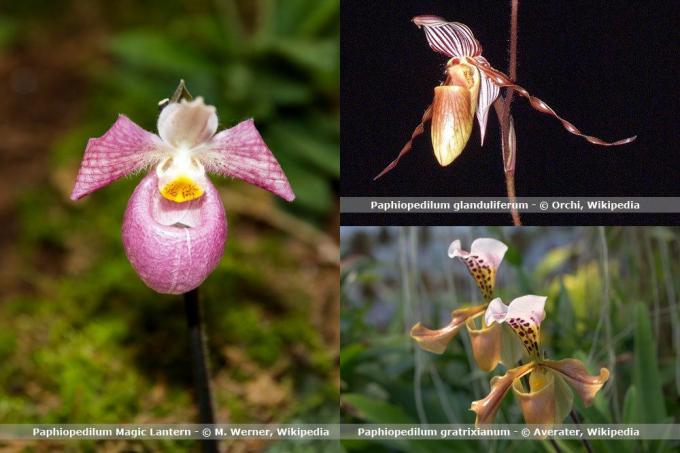
Phalaenopsis
The Phalaenopsis, of which there is an unknown number of special cultivars, which presumably reach into the thousands, can definitely be described as the best-known orchid genus. The special thing about it is the low maintenance requirements, which makes it an ideal plant for beginners.
She feels particularly comfortable on branches and twigs. All species are tall plants and have a leaf dress that feels almost like leather. Depending on the species, the leaves reach lengths between 10 centimeters and one meter. The flowers can have an arched, straight upward or pendulous growth. The following species are particularly well known.
- Phalaenopsis amabilis with classic Phalaenopsis flowers that are available in numerous colors
- Phalaenopsis bellina consists of the color combination of strong white and bright pink
- Phaleanopsis mannii differs from other specimens by its slender petals in green with brown-red tints
- Phalaenopsis gigantea shows itself with unusually large leaves and flowers mostly in red tones
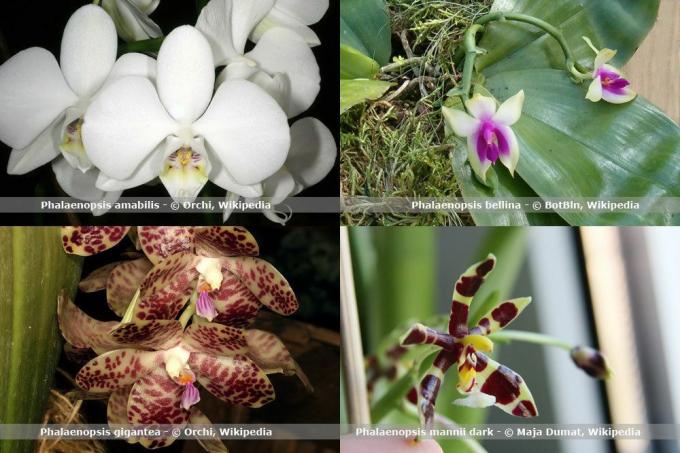
Phragmipedium
The phragmipedium includes around 24 species of orchids. A special feature is the protruding ovary, which is why they are also nicknamed "lady's slipper" because its shape is reminiscent of this. Most of the Phragmipedium species form only one flower per stem. Exceptions can be found among the so-called revolver bloom. Species differences can be found in the choice of location. Some like bright and warm places to stand, while others feel more comfortable in the cooler shade. Well-known examples of single and multiple bloods are the following.
- Phragmipedium besseae whose flowers shine in orange-red
- Phragmipedium lindleyanum has one yellow-green flower per stem and one large ovary
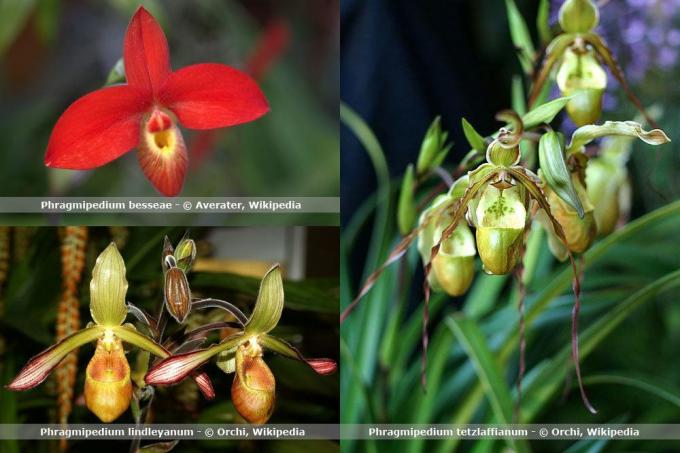
Sobralia
Around 100 species originated from the Sobralia, most of which have their origins in South and Central America. They are sometimes very different, which is particularly evident in a possible plant height of just a few centimeters up to ten meters. The petals are arranged in two rows and not all species have a flower stalk. In some specimens, the bracts overlap. They can be recognized primarily by their three outer leaves, which are distributed around the mostly larger petals. The petals have mostly jagged or wavy edges. The following are among others widespread in Central Europe.
- Sobralia xantholeuca with flowers in pastel yellow to strong lemon yellow
- Sobrailia dichotoma These are available in various shades of white and pink and they have wavy edges of the petals
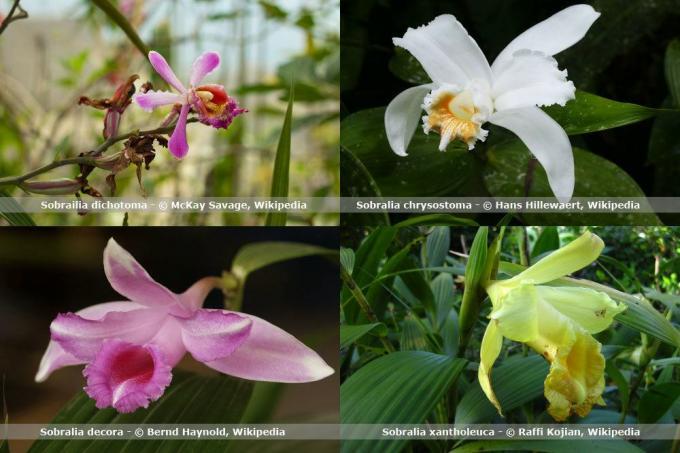
Varieties from T to Z
Trichoglottis
The approximately 60 different orchid species of the Trichoglottis originally come from Southeast Asia. In principle, they are divided into two basic types: hanging stems with small flowers on them and upright orchid types. Examples are those listed below.
- Trichoglottis australiensis as a hanging plant, which is rarely found in Germany
- Trichoglottis brachiata as a standing orchid with velvet red flowers
- Trichoglottis triflora as a standing species with white, small flowers
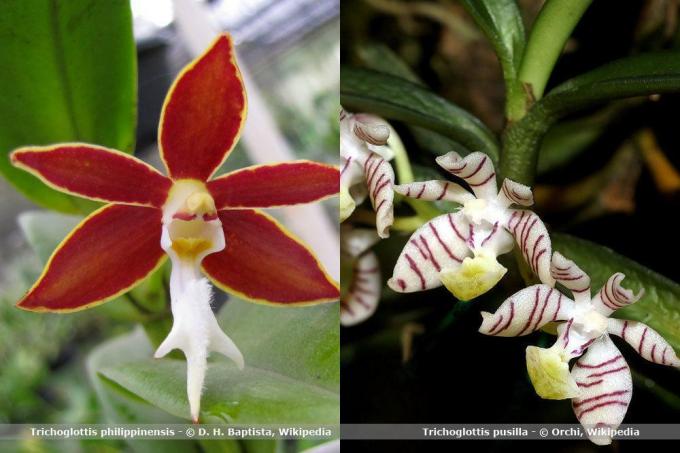
Vanda
The Vanda orchid comprises around 50 different species. They all impress with their brightly colored flowers, which can last for up to six weeks if properly cared for. It is available in classic orchid colors, but also as special varieties with blue flowers. A special feature are the mostly small flowers, which are distributed over the flower stalks and thus somewhat resemble hyacinths. These are among the things that are very popular among orchid lovers.
- Christensoniamum with dense, dusky pink-colored flower clusters
- Vanda ampullaceum catches the eye with its pink, butterfly-shaped flowers
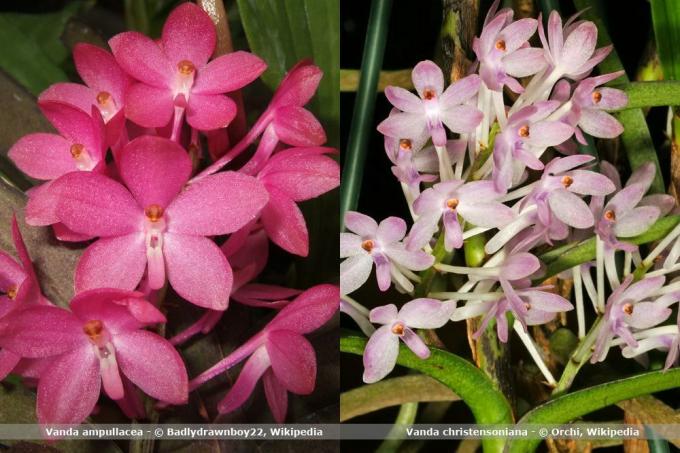
Vanilla
The best-known orchid species among the climbing plants is the vanilla, of which there are several different subspecies, but only one of them is best known in Germany, the Vanilla planifolia or Spiced Vanilla called. It's a creeper. The vanilla spice is extracted from it. The leathery, fleshy, thick leaves and racemose inflorescences in which the yellow or white flowers are closely lined up are striking in all vanilla species.
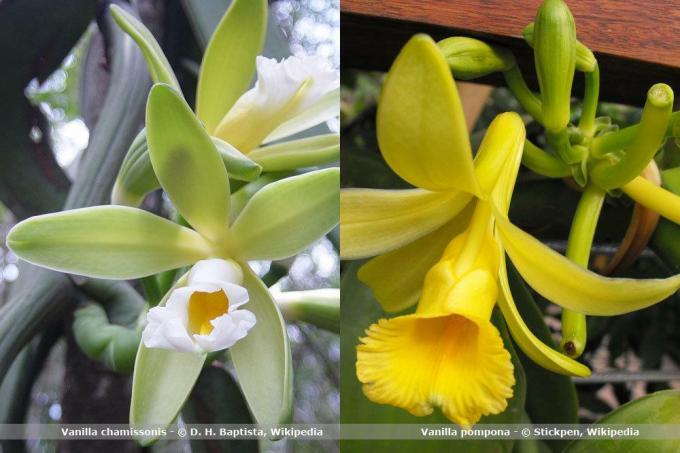
Zygopetalum
The exotic Zygopetalum includes around 15 species, all of which have fragrant flowers. These sit on stems that can reach a length of up to 60 centimeters. The Zygopetalum species are particularly popular because of their long shelf life. The flowers are small or large depending on the species. The flower colors, which give the orchids an additional noble touch with shades in green, red or purple as well as various patterns, are striking. The following are among the most famous examples in Germany.
- Zygopetalum maculatum with white flower lips and blue veins
- Zygopelatum Arthur Elle the variety "Bright and Blue", which has very fragrant flowers and dark blue lips
